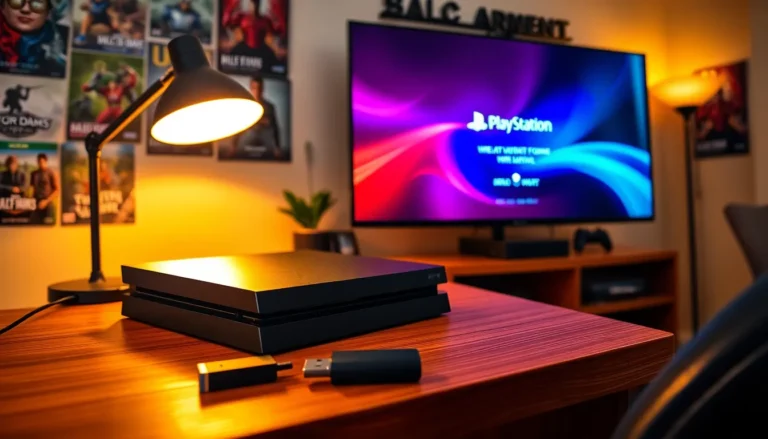Table of Contents
ToggleEver found yourself staring at an app on your iPhone, wondering if it’s frozen in time or just requiring a little nudge? Spoiler alert: it’s probably the latter. Refreshing apps on your iPhone is akin to giving them a gentle wake-up call, no need for coffee. In this guide, we’ll jump into why refreshing is crucial, the different methods to do it, and how to troubleshoot issues that might arise. Buckle up, because your apps are about to get a makeover.
Understanding App Refresh Basics

Refreshing an app on an iPhone is not just a nifty trick: it’s a necessity for optimal performance. Apps, like relationships, can become stale over time. Understanding app refresh basics will give users the power to keep their experiences fresh and engaging. When an app is idle, it can fail to pull in new data, notifications, or updates, leaving users feeling disconnected and frustrated. Simply put, not refreshing an app is like trying to watch a movie on pause, confusing and stagnant. This section will clarify how refreshes work behind the scenes and why they matter.
Why You Might Need To Refresh Apps
Imagine your favorite streaming app suddenly stuttering during the best part of your binge-watch session. Sounds familiar? This is often a sign your app needs a refresh. A myriad of reasons may lead to the need for refreshing apps. Sometimes, a simple network hiccup prevents apps from updating in real time. Other times, pending updates or background processes can cause sluggishness. Regardless, understanding these triggers can save users from unnecessary headaches. By refreshing apps regularly, they can avoid missing out on new features, content, and critical notifications that enhance their overall iPhone experience.
Methods To Refresh Apps
Learning how to refresh apps on an iPhone unlocks a smoother, more interactive user experience. Here are some effective methods to rejuvenate those apps:
1. Manual App Refresh
For a hands-on approach, manual app refreshing is straightforward. Open the app you want to refresh, look for the refresh icon, or simply swipe down on the screen. This action signals to the app that it needs to retrieve the latest data. Many users find it almost therapeutic.
2. Enable Background App Refresh
If manual refreshing feels tedious, enabling Background App Refresh can automate the process. Go to Settings > General > Background App Refresh and toggle it on. This allows apps to update content even when they aren’t in use, ensuring they’re ready to go when launched. Plus, who doesn’t love less waiting time?
3. Restarting Your iPhone
Sometimes, a complete app overhaul requires a reboot. Restarting your iPhone clears temporary files and resets network settings, giving your apps a fresh start. To perform a restart, press and hold the power button until the slider appears, then slide to power off. This reboot is often a reliable way to resolve lingering issues.
4. Updating Apps Manually
Ensuring all apps are up to date can prevent refresh issues and provide users with new features and bug fixes. Open the App Store, navigate to your profile, and scroll to see pending updates. Tapping ‘Update All’ can breathe new life into your apps, ensuring they work seamlessly.
By incorporating these methods into their routine, iPhone users can enjoy a more responsive device.
Common Issues With App Refreshing
Even with the best intentions, users may run into issues when refreshing apps. Some common problems include slow loading times, apps crashing, or failure to display the latest content. A congested network can contribute to sluggishness, impacting the app refresh success rate. Ineffective background processes can also mask app issues, leading users to believe their apps are functioning normally. Getting familiar with these common issues prepares users for smoother resolutions.
Troubleshooting Tips For App Refresh Problems
If refreshing apps feels like an uphill battle, fret not. Here are troubleshooting tips to get those apps back on track:
- Check Your Internet Connection: It might seem basic, but ensuring Wi-Fi or cellular data is active can resolve many refreshing issues.
- Reset Network Settings: If problems persist, resetting network settings may do the trick. Head to Settings > General > Reset > Reset Network Settings. This step refreshes your entire network setup, but note that it’ll reset saved Wi-Fi passwords too.
- Delete and Reinstall Apps: If all else fails, deleting an app and reinstalling it can fix persistent issues. Just tap and hold the app icon, select ‘Remove App,’ and then head back to the App Store for a refreshingly clean install.
- Contact Support: When struggling with unresolvable issues, reaching out to the app’s support team can provide tailored solutions. They might even be aware of specific problems with the app.
With these strategies in their back pocket, users will be well-equipped to handle app refreshing dilemmas.





